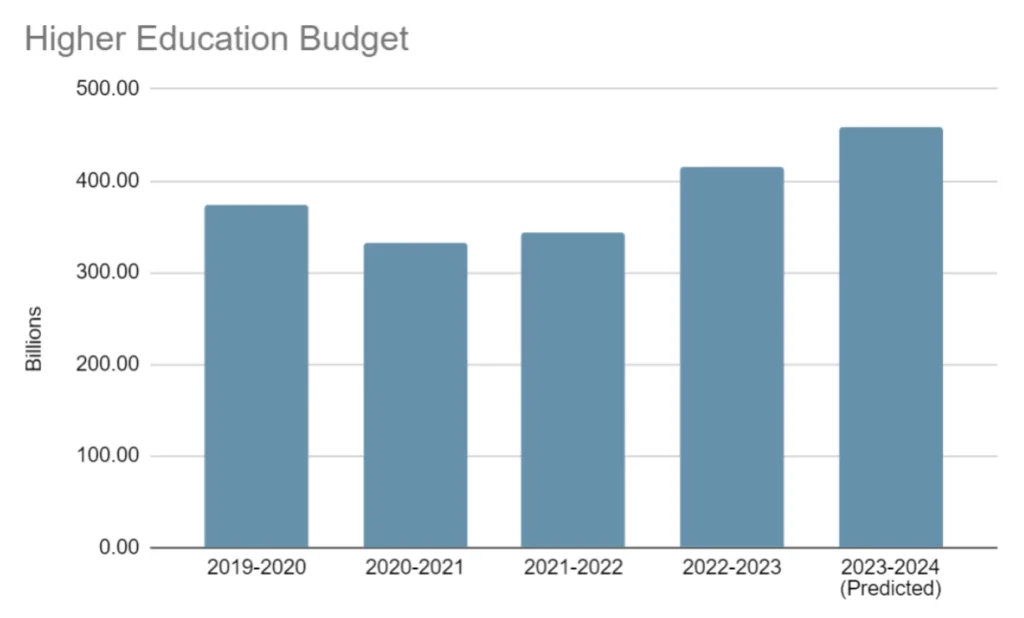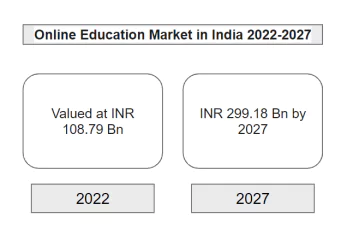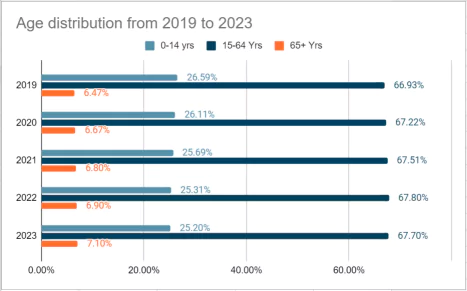In the ever-evolving landscape of higher education, admission processes play a pivotal role in shaping the academic journey of students. At Collegedunia, we’ve delved into the wealth of data that we’ve collected to uncover noteworthy trends in admission processes. Our insights aim to shed light on changes in entrance exam patterns, admission rates, and the transformative impact of online learning.
Academic assessments are entering a new era as a result of a dynamic evolution in the field of admission exams characterized by creative modifications. Our data analysis highlights rapid developments in techniques, indicating a shift from traditional assessment procedures. Notably, adaptive testing is becoming a popular trend. It offers personalized evaluations by adjusting the complexity of questions based on test-taker performance, all while drastically cutting down on test length.
Simultaneously, there’s a rising recognition of the value of critical thinking abilities above rote memorization, which helps candidates become proficient in handling problems in real-world situations. The worldwide health crisis has expedited transformations even further, as conventional pen-and-paper methods have given way to online and remote proctoring options that guarantee security and integrate digital technology. Furthermore, holistic admissions standards are becoming more popular, with colleges taking into account variables other than academic performance to assess candidates, including extracurricular activities and personal statements, acknowledging a spectrum of talents and experiences.
With the use of technology, especially artificial intelligence, entrance exam administrative procedures are changing. Automated systems for registration, plagiarism detection, and score reporting improve efficiency and integrity while making tasks easier for both test-takers and administrators.
As institutions continue to embrace these changes, they not only ensure a fair and comprehensive assessment of candidates but also contribute to the ongoing evolution of educational evaluation methods.

Source – Collegedunia’s dataset
Changing Preferences of Aspiring Students:
Students are reframing their selection criteria in the current landscape of higher education, placing a greater emphasis on experiential learning, sustainability, and diversity. They look for colleges that value diversity, cultivate an inclusive atmosphere, and offer forums for a range of viewpoints. Students are increasingly choosing universities that are dedicated to environmental responsibility and green activities, making sustainability another important factor to take into account. In addition, students place a high emphasis on practical experiences, internships, and comprehensive career support programmes as ways to improve their employability after graduation.
Another significant element influencing their decisions is the technological infrastructure, which includes cutting-edge facilities and creative teaching techniques. In general, students want an all-encompassing education that goes above and beyond conventional academic measurements and is consistent with their ideals of career development, diversity, sustainability, and experiential learning.
The world needs not just doctors, IT geniuses and high-flying lawyers, it needs trained agriculturalists who can increase the production of quality food grains; teachers who can guide the next generation of children, imparting quality education to them; and environmentalists who can protect the rich flora and fauna around us. There are several vocations that need skilled people to practice and make good use of them.
Fluctuations in Admission Rates:
Higher education admission rates are subject to dynamic variations that are impacted by a multitude of factors. The changing economic environment is one important factor. Higher education becomes more popular during economic downturns as a result of increased rivalry for jobs, which in turn causes an increase in applications and a decrease in admission rates. On the other hand, less rivalry for jobs during economic booms could lead to fewer applications and greater acceptance rates. Furthermore, much as changes in popular fields of study affect the distribution of applications across academic programmes, society views and preferences also influence acceptance rates. Demand for cutting-edge fields like data science and technology may rise, affecting admissions to these schools.
Variations in admission rates are also influenced by modifications to educational laws and government policy. Changes to reservation quotas, scholarship programmes, or affirmative action rules may have an impact on candidate demographics, which in turn influences admission rates in all fields. Global occurrences like the COVID-19 epidemic bring in new difficulties that affect testing policies, institutional capacity, and student mobility. As a result, when institutions adjust to the new reality, admission rates fluctuate.
Though India’s role in the international education landscape has historically been as a top sending country, its star is rising as a destination for international students. Toward that end, India’s overlapping goals of expanding access to higher education among all students in the country, keeping talented Indian students at Indian institutions, and attracting students from abroad all begin with prioritizing its higher education system.
In the last 2 years, the pandemic has compounded existing challenges in India, including those related to capacity, equity, access to resources, quality, and bureaucratic obstacles. But reform efforts to address these issues and others are taking root as India’s tertiary sector experiences a period of tremendous expansion.
To appreciate the country’s growing role in international education, it’s important to understand the scope of India’s higher education system, as well as its various models, strengths and weaknesses, and largest obstacles.

Rise of Online Learning:
The advent of online learning has fundamentally changed the educational environment and altered conventional admissions procedures. Physical classrooms and on-campus experiences are becoming less common, as virtual classes and distant education become more common. With the ease, affordability, and accessibility of online learning, students can pursue their education from any location in the world and at their own speed. This change has brought about a revolution in the education sector, bringing with it both opportunities and challenges.
One of the main benefits of online learning is convenience; it frees students from the limitations of a traditional classroom and lets them access assignments and course materials from any device. Additionally, because of their scalability and decreased administrative expenses, online courses are frequently more affordable, which benefits students monetarily. Still, questions remain about how well online instruction engages students, as the absence of interpersonal contacts that characterize traditional classroom settings may have an adverse effect on students’ motivation and engagement with the learning process.
As per TOI, the advancement of online education has transformed the education industry and brought new opportunities and challenges to traditional schools. Online education increases the freedom to learn, making learning more accessible, flexible and affordable. The emergence of new teaching and learning methods has created new challenges and opportunities for schools. Traditional schools must adapt to the new digital learning environment, invest in new technologies and innovations, and innovate to remain competitive. Online education creates new challenges in terms of quality control and accreditation, but also provides new opportunities for institutions to expand their reach and impact. Overall, online education has had a significant impact on traditional schools, and its impact will continue to grow in the coming years.

Demographic Shifts in Applicant Pools:
Strong changes in the student population within India’s higher education system are visible, denoting a break from conventional wisdom and promoting a more inclusive and diverse environment. There has been a noteworthy shift in the geographic distribution of applicant pools, as more students from all across the country are applying instead of just their native states or regions. This pattern indicates that students are becoming more willing to investigate educational options outside of their immediate geographic area, which broadens the pool of applicants in terms of geography.
Furthermore, the conventional perception of youthful university candidates is being challenged by a noticeable increase in applications from senior and non-traditional students. People of all ages are realizing how important it is to keep learning and upgrading their skills in order to compete in the employment market, indicating a wider recognition of the importance of lifelong learning for both professional and personal growth.
Read the article to understand more about changing trends in education
Furthermore, increased socioeconomic diversity in candidate pools is being fostered by attempts to improve accessibility through online learning platforms, financial assistance, and scholarships, creating a more diverse and accessible higher education landscape in India.
As per TOI, “Demography is destiny, and India’s destiny is youthful.” This statement by the Hon’ble Prime Minister Shri Narendra Modi highlights the importance of India’s large and growing young population. This demographic advantage presents an opportunity for the country to leverage its human capital potential and drive economic growth and development. The expansion of higher education in India is a positive development that holds great potential. As a country with a rich history of learning, India has made significant strides in higher education in recent decades. However, it is important to examine how the benefits of this expansion have been distributed among different social groups. While progressive state policies of affirmative action have improved access to higher education for all segments of the population, empirical evidence suggests that regional and socio-economic inequalities persist, highlighting the need for continued efforts towards greater equity and inclusivity.

Technology’s Role in Streamlining Admissions:
Entry-level university environments are changing dramatically as a result of the use of advanced technology in the admissions process. The use of artificial intelligence (AI) algorithms for application analysis is one noteworthy advancement. Organizations can effectively assess several aspects, like the appropriateness of a candidate, with the help of these AI-powered tools that analyze vast databases to find patterns and trends. This quickens the screening process and reduces bias, guaranteeing that each application will receive a fair evaluation.
Furthermore, user-friendly online application processes have supplanted old forms in modern admissions procedures, with digital presenting platforms emerging as a crucial component. Electronic document submission eases administrative workloads for admissions offices and applicants alike. Furthermore, the use of virtual assistants and chatbots streamlines communication between admissions offices and potential students, offering prompt answers to questions and assistance with the application procedure for candidates. Additionally, data analytics is essential since it gives universities demographic and application trends information, which helps them better target outreach and admissions campaigns.
The integration of Generative AI in the admissions process of educational institutions, particularly for management education, marks a significant leap forward.
By automating personal interviews, this technology not only streamlines the admission process but also ensures a more fair, unbiased, and inclusive assessment of candidates.
While challenges such as data security and the need for a balance between AI and human judgment remain, the potential benefits are immense. Generative AI is poised to transform admissions, making them more efficient, scalable, and equitable, thereby shaping a more inclusive future for education.
Conclusion:
It is vitally important for educational institutions to be aware of current developments in the complex world of admissions processes. Our data-driven insights give institutions looking to adapt and prosper in the ever-changing higher education landscape not just a thorough picture of the current situation but also priceless insight.
With precise and predictive data at their disposal, educational institutions may make well-informed decisions to optimize their operations when admission requirements and applicant preferences change. Comprehending the changing demographics, technological progress, and socioeconomic factors empowers institutions to customize their outreach, improve inclusivity, and tackle new issues. Furthermore, predicting future trends enables proactive modifications to admissions practices, guaranteeing that universities maintain their competitiveness and flexibility in response to the evolving requirements of prospective students.
By utilizing insights derived from data, educational establishments can encourage a more nimble and robust admissions process. Institutions can better navigate the intricacies of admissions and proactively shape the future of higher education by embracing innovation and staying ahead of the curve. This creates an environment that is welcoming, adaptable, and in line with the goals of the changing student body.






